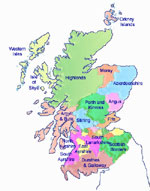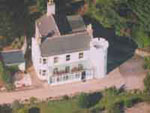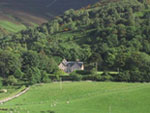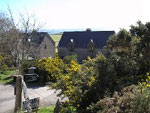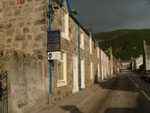|
|
Welcome to Helmsdale Scotland
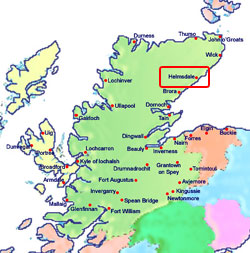
Helmsdale's annual Highland Games are held in a dramatic setting overlooking
the village.
Accommodation around Helmsdale
Price Guide - per person based on sharing room:  under $40 -
under $40 -  $41
- 70 - $41
- 70 -  more than
$70 more than
$70
Introduction to Helmsdale
Nestling below Creag Bunillidh the traditional Highland fishing
village of Helmsdale is the ideal base from which to explore Sutherland.
Situated at the mouth of the River Helmsdale (from which it takes its
name) it has a lot to offer the visitor.
The village was planed at the time of the Highland Clearances in the early
19th century, on the site of an ancient settlement. Located as it is on
the shores of the Moray Firth, it is natural that many of the local community
make their living from the sea. The herring industry (the silver darlings)
brought prosperity to the village until the beginning of the last century
and, although the boom is now over, the visitor can still stand at the
picturesque harbour and watch fishing boats prepare to reap today's harvest
of lobster, crab and white fish.
Using Helmsdale as your base, John o'Groats and the Orkney Islands are
within easy reach and the whole of Sutherland is at your doorstep. For
the visitor from the city, for whom driving has ceased to be a pleasure,
the quiet roads of the country will bring joy back to motoring and you
can explore the unspoilt loveliness of the area. Or simply park your car
and enjoy what the village and surrounding countryside have to offer.
Sit by the harbour and watch the boats come and go, explore the beaches
for gemstones, play tennis or golf, squash or carpet bowls, go bird watching
or hill walking. Fish for salmon or sea trout on the association water,
or visit one of the many lochs in the area for brown trout fishing. Visit
some of the many ancient brochs and cairns or spend an afternoon at nearby
Dunrobin Castle. When night eventually falls, call into one of the hotels
for a friendly chat, or have a good meal of local venison, salmon lobster
or crab.
There is entertainment in the village throughout the season and visitors
are always welcome. One of the highlights during the summer is the Helmsdale
highland Games where the top Scottish athletes, pipers and dancers compete.
The 30th Highland Games this year will be held on Saturday the 21st of
August 2010.
The river Helmsdale tumbles and winds its way down the beautiful Strath
of Kildonan and is one area which no visitor should miss from his itinerary,
as there is so much to see. The Strath abounds with wildlife and history,
including the historic church at Kildonan and Baile an Or and Suisgill,
sites of the great Sutherland Gold Rush of 1869. Many men from all over
Britain came in search of gold and there is still gold today. You can
still pan for gold, details can be obtained from Strath Ullie Crafts .
East Sutherland is one of the lowest rainfall areas in Scotland, and here
in the north, we can boast the longest summer days.
Helmsdale has two restaurants the La Mirage where stars of television,
film and literature are among the many visitors the new resturant is the
Green Stag restaurant it is open seven days a week pays homage to Scotland’s
best produce. Three hotels the Bridge hotel, the Belgrave with its Bel-Grill
Restaurant and the Navidale House Hotel. One pub the Bannockburn all serve
excellent meals.
There is also a number of small shops. McColls (convenience stores) in
Trentham street and in Dunrobin Street you will find the Spar shop, Helmsdale
tackle Company everything you would want to know about fising flies, A.
R. MacLeod & Sons for hardware, Twentieth Century Collectables for
Jewellery, Antiques and Interesting Curios for all pockets also Gilbert's
Tearooms Restaurant and Antique Shop. In Sutherland street is A &
D Family wear. The new community centre serves as the Library, and If
you wander down to the harbour you will find Strath Ullie Crafts and this
is also the tourist information centre for Helmsdale.
History of Helmsdale
The first written reference to the people of this area, at the
end of the first century AD comes from the Roman historian Tacitus, who
described the people as tall, red headed men who fought bravely with long
swords and round shields. St Ninian came here about 390 AD and preached
at Navidale. Where the old church yard now stands there was a chapel which
was burned down during the Reformation in 1556. Helmsdale came under the
Parish of Kildonan which gets its name from the pictich word Kil or Cill
or Cell, this meaning the cell of St Donan, patron saint of the Strath,
from 580 AD. Christianity, however, came under attack in the 9th century
when the Vikings began their raids into the North of Scotland.
Tharfin the Great conquered Scotland down to the Moray Firth, and certain
cairns and standing stones are said to mark the sites of many ferocious
and bloody battles. It was at Helmsdale (from the Norse Hjalmundal Dale
of the Helmet) that a great battle took place between two Nors chiefs
Swein and Olvir Rosta. Swein won a great victory and Olvir's men retreated
to some houses which were burned with all their inmates. Olvir escaped
by crossing the Helmsdale river and was not heard again. Swein and his
men committed many ravages in Sutherland before returning to their ships.
As the Vikings mixed with the native population, the clan system evolved
and the way of life changed little from century to century. There were
periods of blood and strife mainly caused by lust for land and cattle.
The chieftain had power of pit and gallows over all men and yet was regarded
by his clansmen as protector and father figure.
Helmsdale Castle
The Couper Park is the site where the Helmsdale Castle once stood. Although,
alas it became a rapidly crumbling ruin and was completely demolished
in the early 1970s to make way for the new A9 road bridge over the Helmsdale
River.
The castle had its beginnings in the 1460s. It was repaired and enlarged
around 1600, but it was in 1567 that the famous tragedy was enacted that
is said to have inspired the plot of Shakespeare's "Hamlet".
Isobel Sinclair, in a diabolical attempt to divert the line of succession
to her own son, arranged to poison her visitors, the 11th Earl of Sutherland
and his Countess and their son, while they were taking dinner at the castle.
But the plan miscarried and the Earl's son did not drink the poisoned
wine, while her own son did, as well as the Earl and Countess.
The original castle was square in shape and had been the hunting seat
of the Sutherland family. A find in the Kildonan Strath was a cast iron
fireback dated 1633. The grandson of the 11th Earl records that his brother,
Sir Alexander Gordon of Navidale, was responsible for the repair of the
castle, and his two sons were born there in 1614 and 1616; but in 1621,
when the clan troubles were at their height, he built a castle at Torrish,
in the Strath, and presumably took the fireback up to it. These ornamental
slabs of cast iron were introduced when fireplaces were built into the
wall, instead of the usual simple structure in the middle of the room.
The Way of Life
The way of life during this period is of interest. Millstones
from all the mills in the parish were made from the huge porphyritic rocks
from Beinn Chriammhor. Kilphedir burn turned the largest mill in the district.
Open boats, about 14ft. long, were used for fishing, and the hand lines
baited with mussels and limpets. Trades at this time were "coopers",
"gutters" and "packers", and fishing nets were made
by the women with white bone needles. The "furnishings" of a
house would probably consist of a clay floor, 3-legged stools, deal tables,
horn spoons, meal girnels,tallow candles and iron saucers filled with
fish oil to act as lamps.
Houses in the 17th and 18th centuries were constructed mostly of stone
to a height of about 3ft-then layers of turf or "fail" to bring
it up to 10ft. or so. The roof was made of thatched heather, or an alternative
was branches of birch covered with divots of turf and then thatched with
a thin layer of straw held in place with ropes made from heather.
Some Most Interesting Facts
Some most interesting facts are known about conditions in this
village at the end of the 18th century. Corn was imported via Little Ferry,
Golspie, and men from the village went thither on horseback to fetch supplies,
fording all the streams as there were no bridges. A "corf house"
stood at the mouth of the river for collecting the corn rents of the tenants.
Down by the shore were the salmon fishery buildings, long and low, and
roofed with red tiles. On the beach were many smalls yawls and smacks,
while about a mile from the river mouth were the cruives for intercepting
the salmon.
A boiling house cooked the salmon taken from the rivers of Helmsdale,
Brora and Shin.
At this time there were no fewer than eight "whisky houses"
in Helmsdale; and the only school, at Loth, had 40 pupils. As late as
1730 Sundays were devoted to athletics, such as weightlifting and tossing
the giant moss firs ("cabers").
In 1864 the first entry was made in the log of the present school (not
the present building). A payment of pennies was taken weekly by each scholar
to the school and pieces of peat daily. The Free Church school was built
on the site of the present Free Church, and the parish school was in Lillieshall
Street. In 1882 the schools came under management of the State, and the
former school building (now converted to flats) was erected in 1883.
The early 19th century
Many noble households squandered large inheritances. For example
Lord Reay, Caithness lost his whole estate overnight at the gambling tables
of London. In the case of the Sutherlands, however, a large proportion
of their wealth was used to benefit their estates and, in so doing, the
lot of the local inhabitants. This latter aspect involved not only improving
communications, but also. In the longer term, living conditions.
In Sutherlandshire the work done resulted in communication improvements
which upgraded the road system out of all recognition, and also brought
the railway to the area. The latter scheme both improved future trading
prospects, and relieved the hardships of 1870.
Other measures introduced to benefit the local inhabitants included work
at Brora to improve the coal mine, starting an engineering workshop there,
as well as carpet factories at Embo, Lybster and Helmsdale. Loans were
made to fishermen to purchase new boats, and large sums were laid out
on planned villages at Helmsdale and at Brora.
Finance for all this work was only available because, in 1803, the Marquess
of Stafford, husband of Elizabeth, Countess of Sutherland, later to be
made 1st Duke of Sutherland for political services, inherited a very large
annual income from his uncle, the Duke of Bridgewater. This was in the
form of canal profits.
The Marquess decided to use a large part of this legacy to upgrade his
wife's Sutherland estate whilst at the same time seeking to improve the
estate's profitability. This he wanted to do by converting to sheep farms
the large tracts of the land occupied by many small tenants mostly involved
in cattle rearing. Just how necessary it was to improve the road system
will be appreciated when it is realised that up to that time there was
only one bridge in the whole estate of 1'250 square miles. This was at
Brora and was used to convey coal from the mine to the harbour. There
were no roads at all capable of handling wheeled traffic.
He seems to have been very badly advised about the conversion of the land
to the raising of sheep and also about the men to carry it into operation.
This involved the large scale eviction of tenants which, in many cases,
was carried out in an outrageous and inhuman fashion, especially during
the period 1810 - 1825. This resulted in hundreds of local Sutherland
people emigrating to Canada and New Zealand. Those remaining, with great
fortitude, created new livelihoods in coastal areas such as Helmsdale,
but endured initially the most abject poverty and deprivation.
Obviously the expenditure involved was massive, and whilst an Exchequer
contribution of 50% of approved outlays was available this only applied
to the main roads, or in the Sutherland case about 90 miles out of the
overall total of 500 miles.
Besides the road works there were constructed the Telford Bridge at Helmsdale,
(costing £2,200), one hundred and thirty four other bridges, and
two chain ferries for river crossings considered to long to bridge.
When allied to the complementary schemes for inns and stabling at Clashmore,
Golspie and Portgower, and a post office at Dornoch, these improvements
enabled the Estate to persuade the Post Office to extend the Royal Mail
northward from Inverness. Consequently, although it was to be a further
ten years before all the bridges were in place, by 1819 stage coaches
were travelling through Helmsdale up to Wick and other north coast towns,
and so Helmsdale became a convenient resting place for horses and travellers
either about to tackle the stresses of the Ord with its exposed roads
and steep inclines, or to rest from their after affects.
Before the new roadwork's began, there were only a small inn and a few
cottages round the mouth of the Helmsdale river for those who were working
on the nearby salmon boiling and pickling plant. In 1762 the inn was described
by the Right Reverend Robert Forbes as having "a little snug garden
made out of the Greatest Wild with his own hand; in which we saw Gooseberries,
Apples, the hundred-leaf'd Rose, White Lillies,....Firs, Ash, Beech, Oak...and
Cauliflowers" He also mentions that " the sea flows up at Tides"
almost to the door and that "At the mouth of the water of the Helmsdale
there is good Salmon-Fishing, plenty of trout, and a Safe Inlet for Fishing".
On another journey he mentions that he "dined at Helmsdale on Mutton-Collaps,
and new baked Salmon".
To cop with the additional work the Sutherland Estates required additional
staff in the factor's office. Amongst those engaged was an 18th century
"whiz kid", William Young, who had made a success of a similar
situation on his own smaller estate near Elgin.
During an inspection of the construction work on the bridge, William Young
focused on the possibilities of developing the surrounding area commercially,
and reported to the Marquess in 1810 that "Helmsdale seems well adapted
for a Fishing Station both from its local situation, and, as the adjoining
sea is known to contain Cod, Ling, Haddocks, and other white fish, here
the Moray Firth Fishermen frequently come to set their lines. Immediate
steps should be taken to get possession of some ground suitable for a
Village and to induce Fishermen from the south side to settle at this
place".
At the time of Mr Young's report, the major part of the land there was
held by Lord Hermand in wadset (a type of loan/lease arrangement) so,
whilst it was 1816 before full legal access could be gained to the major
part of the targeted area, construction of this new planned village had
commenced in 1814 and it was not long before expenditure of around £20
million in 1990 terms had provided the start of the neat streets of houses
we see today, as well as a fish curing shed, and then later, a distillery
and a carpet factory.
The area round the harbour was built, but not all of the projected streets.
As well as developments on land the number of fishing boats based at Helmsdale
had risen from 20 in 1814, to 204 in 1819.
The Helmsdale Ice house
The Helmsdale Ice House is one of the best examples of its kind on the
Sutherland Estates, and is now a scheduled ancient monument, registered
under the scheme operated by Historic Scotland, which gives it legal protection.
It was the Chinese in the 13th century who first realised the potential
of ice as a preservative, and in the mid-1700s Alexander Dalrymple, a
traveller in the Far East, brought perishable goods back to Britain packed
in ice. The Scottish merchant and philanthropist, George Dempster of Skibo,
promoted the technique in 1786 and may have been involved in the development
and design of Helmsdale's ice house.
The village had two ice houses originally: one at the harbour for white
fish, which was demolished in the early 1990's and the present one near
the war memorial at the mouth of the river, which was used for the preserving
and packing of salmon. The ice house, built into a natural brae, was constructed
of free stone and comprises an ante chamber where packing took place and
a vaulted room where the ice was stored. The roof was covered with a layer
of soil and turf, giving better insulation, and there are two openings
- a doorway at floor level to give access to pack the salmon, and a hatchway
at the back of the roof, accessible from the outside, for loading the
blocks of ice into the building. Both openings have double doors and hatches
for improved insulation.
There is still visible to this day the outline of a shallow construction
behind the ice house, which formed a lake fed by a spring. During the
hard winter months, the water froze and the ice was transported by horse
and cart to the hatchway for loading into the chamber by a stone-paved
chute. Labour was plentiful as during a harsh winter very little work
could be carried out on the land.
During the mild winter ice was imported from Norway. The ice was packed
in layered sawdust, again for better insulation and to make it easier
to handle when it came to packing the fish.
The flagstones on the floor of the chamber were laid with gaps between
for drainage purposes, but the construction was so well insulated that
the melting process was very slow and the ice lasted most of the summer.
The local fishermen took out leases to catch salmon around the foreshore,
and the fish were transported to the ice house for packing. The salmon
were packed in full, half or quarter boxes, nose to tail with a layer
of ice and greaseproof paper between each layer. The fish were then transported
to Aberdeen by boat and latterly by rail to Edinburgh and Glasgow.
Shortly after the Second World War the antechamber of the ice house was
used as a fish and chip shop, and in the early 1990s renovations were
carried out to the outside of the building and the area spot-lit to make
it an attractive and interesting visitor attraction.
Land League Cairn
A cairn was erected at Gartymore on the croft of John Fraser,
a leading light of the land reform movement, the first branch of the Sutherland
association, the parent of the Highland Land League. These men by their
efforts succeeded in the Highland Land League.
Click plaque for readable size
These men by their afforts succeeded in bringing about the first crofting
reform acts, ensuring security of tenure for crofters that they would
never again be "treated by owners of tenure of the soil as good for
nothing, but to be cast out trodden under feet of men"-(Sage) |
![]() Email enquiries & reservations: bookscotland@madbookings.com
Email enquiries & reservations: bookscotland@madbookings.com